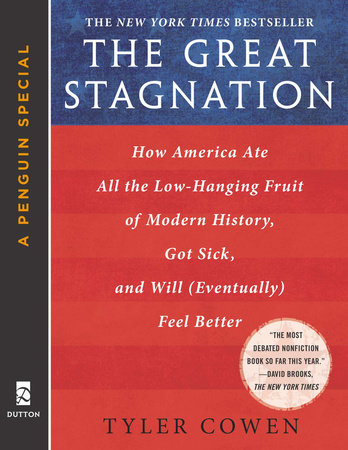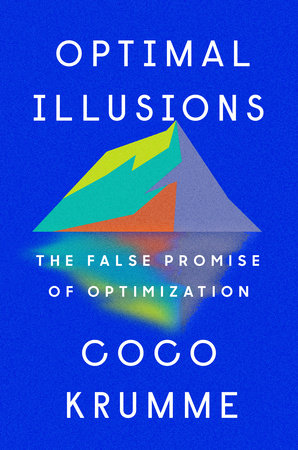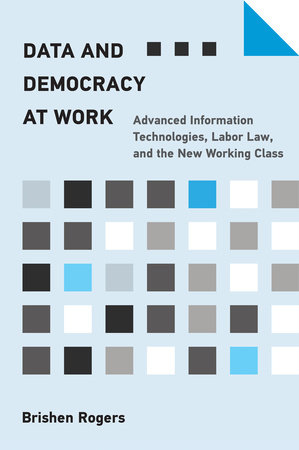Quick Summary
One Sentence Summary
“The Great Stagnation” by Tyler Cowen explores the slowdown in innovation and economic growth in advanced economies, arguing that we have picked all the low-hanging fruit of technological advancement.
Big Idea
Cowen posits that the rapid growth and innovation witnessed in the past were largely due to easily accessible and transformative ideas and technologies. He suggests that we have entered an era of stagnation due to the exhaustion of these low-hanging fruits and the increasing complexity of achieving breakthroughs.
Five Key Ideas
- Historical Growth Drivers: Exploration of how past growth was driven by significant technological advancements and easy gains.
- Stagnation Symptoms: Identification of signs of stagnation in productivity, wage growth, and technological breakthroughs.
- Education and Inequality: Discussion on how the education system and growing inequality contribute to the stagnation.
- Government Role: Analysis of government policies and their impact on innovation and economic growth.
- Future Outlook: Speculation on potential pathways out of stagnation, including fostering new technological breakthroughs.
Actionable Advice
- Encourage Innovation: Foster environments that encourage creativity and innovation.
- Reform Education: Adapt the education system to meet the demands of a changing economy and technology landscape.
- Rethink Government Policies: Advocate for policies that stimulate economic growth and innovation.
About the Author
Tyler Cowen is an American economist, academic, and writer. He is a professor at George Mason University and co-author of the popular economics blog Marginal Revolution. Cowen’s work spans several topics, including economics, culture, and politics.
Read Next
- “Average Is Over” by Tyler Cowen: Explores how technological advancements will reshape labor markets and economic stratification.
- “The Second Machine Age” by Erik Brynjolfsson and Andrew McAfee: Offers insights into how the digital revolution is transforming our economy.
- “Rise of the Robots” by Martin Ford: Investigates how automation and AI are impacting jobs and the economy.
In Depth
Historical Growth Drivers
The first key idea of “The Great Stagnation” revolves around the drivers of historical growth. Cowen argues that much of the economic prosperity experienced in the past was due to groundbreaking technological advancements and the exploitation of easily accessible resources. These factors served as catalysts for rapid growth and development, but now, according to Cowen, we are facing a slowdown as these opportunities are becoming scarce.
One of the most prominent examples Cowen discusses is the impact of industrialization. The transition from agrarian societies to industrial ones brought about significant changes. It led to mass production, urbanization, and profound shifts in labor and economic structures. This transition was akin to picking low-hanging fruit; the initial gains were enormous and relatively easy to achieve.
Cowen points out that during the 19th and early 20th centuries, major inventions like the steam engine, electricity, and the internal combustion engine fundamentally transformed economies. These innovations led to new industries, improved transportation, and enhanced productivity. They were transformative because they were general-purpose technologies, meaning their applications were broad and far-reaching.
A detailed example Cowen uses to illustrate this point is the development of antibiotics. The discovery of penicillin, for instance, had a profound impact on public health. Before antibiotics, minor infections could be fatal, and surgeries were extremely risky. The introduction of antibiotics drastically reduced mortality rates and increased life expectancy. This breakthrough was a game-changer, but it was also a form of low-hanging fruit. The initial discovery and development of antibiotics yielded tremendous benefits with relatively straightforward research compared to the complexities of medical research today.
Cowen highlights the contrast between past and present innovations by stating:
“In a nutshell, the low-hanging fruit we had been enjoying for centuries, if not millennia, included technologies such as the steam engine, fossil fuels, electricity, radio, the internal combustion engine, computers, and antibiotics and other medical advances.”
This quote encapsulates the essence of Cowen’s argument. The historical growth drivers were potent because they were foundational and transformative. However, as these low-hanging fruits have been picked, further advancements require more effort, resources, and ingenuity.
Today’s innovations, while significant, often lack the widespread transformative power of past inventions. Advances in technology and medicine continue, but they tend to be more incremental and less revolutionary. As Cowen suggests, the challenge now is that we are facing diminishing returns on new technologies, making it harder to achieve the kind of rapid growth seen in the past.
Understanding this key idea is crucial to grasping Cowen’s overall argument in “The Great Stagnation.” It sets the stage for discussing the current symptoms of stagnation and exploring potential solutions to overcome this period of slowed growth and innovation.
Stagnation Symptoms
The second key idea in Tyler Cowen’s “The Great Stagnation” addresses the symptoms of stagnation that are evident in advanced economies. Cowen argues that the signs of this stagnation are not hidden; they are manifest in various aspects of the economy and society. These symptoms include a slowdown in productivity, wage stagnation, and a scarcity of groundbreaking technological breakthroughs.
Cowen specifically points out the stagnation in median income as a clear indicator. For decades, the median income in advanced economies, particularly in the United States, saw robust growth. However, this growth has significantly slowed since the 1970s. Cowen asserts that this stagnation in wages is not just a result of economic cycles but a symptom of deeper issues related to the slowdown in innovative breakthroughs and overall economic growth.
Another symptom Cowen delves into is the decline in productivity growth. In the past, leaps in productivity were common, driven by major technological innovations and efficiencies in industries. Now, productivity growth has slowed, suggesting that the economy is not benefiting from transformative innovations as it once did.
A detailed example Cowen uses to illustrate this point is the contrast between the innovations of the 20th century and those of the 21st century. He compares the revolutionary impact of inventions like the automobile and electricity with more recent innovations like the internet and smartphones. While the latter are significant, Cowen argues that their impact on productivity and overall economic growth is less dramatic.
To highlight the difference in the impact of these innovations, Cowen states:
“Today, in contrast, apart from the seemingly magical internet, life in broad material terms isn’t so different from what it was in 1953… We expected flying cars and got 140 characters instead.”
This quote underscores Cowen’s perspective that recent innovations, despite their cultural and social significance, have not propelled the economy forward in the same way as earlier technological breakthroughs. The internet, social media, and smartphones have changed the way we communicate and access information, but they haven’t led to a significant surge in productivity or radically transformed the economy’s structure.
Furthermore, Cowen touches on the lack of significant breakthroughs in other fields like energy, transportation, and medicine. While there are advancements, they are often incremental improvements rather than fundamental shifts. This slowdown in transformative innovations contributes to the broader stagnation Cowen describes.
Recognizing these symptoms is crucial for understanding the challenges facing advanced economies. Cowen’s identification of these stagnation symptoms sets the stage for exploring the underlying causes and considering potential solutions. It paints a picture of an economy that has moved away from the era of rapid, transformative growth to one where progress is more incremental and fraught with challenges.
Education and Inequality
In “The Great Stagnation,” Tyler Cowen delves into the intricate relationship between education, economic stagnation, and growing inequality. He argues that the current education system is inadequately prepared to address the challenges posed by a stagnating economy. Furthermore, Cowen highlights how this educational shortfall contributes to widening inequality.
Cowen emphasizes that the educational system, once a driver of economic growth and equalizer of opportunities, has become less effective in these roles. He notes that the quality of education hasn’t kept pace with the changing economic landscape. The system is often criticized for being outdated, not aligning with the skill sets required in a modern economy, and failing to foster the level of innovation needed to push the economy out of stagnation.
A detailed example Cowen provides is the rising cost of education, especially higher education. He points out that while the cost of obtaining a college degree has skyrocketed, the economic returns of that degree have not increased correspondingly. This mismatch leads to a scenario where education is less of an investment in the future and more of a financial burden, especially for the middle class.
Cowen articulates this concern by stating:
“We have built an education system based on the assumption that everyone can be above average, and we have further pushed costs up to a level where this is decidedly not the case.”
This quote highlights the fundamental issue Cowen identifies: the education system is not only failing to adapt to new economic realities but also becoming increasingly unsustainable financially. It’s not providing the expected returns, and this fuels inequality. Those who can afford quality education get ahead, while others are left behind, exacerbating the divide.
Moreover, Cowen addresses the growing inequality in terms of access to opportunities. He notes that as the economy stagnates, the competition for well-paying jobs becomes fiercer. Those with better educational backgrounds or resources have an advantage, leading to a situation where economic mobility is hampered. This lack of mobility is a symptom of the broader stagnation Cowen describes and contributes to the growing gap between the wealthy and the poor.
Understanding the link between education, economic stagnation, and inequality is crucial in Cowen’s analysis. It sheds light on systemic issues that need addressing to overcome stagnation. By focusing on education and inequality, Cowen points towards areas where reforms and innovations could kick-start growth and, importantly, make that growth more inclusive.
Government Role
In “The Great Stagnation,” Tyler Cowen scrutinizes the role of government in the context of economic stagnation. He contends that government policies and interventions have significant implications for innovation and economic growth. Cowen examines how governmental actions can both hinder and help in overcoming stagnation.
Cowen points out that government spending has increased over the years, but this increase hasn’t translated into corresponding economic growth or productivity. He suggests that much of the government expenditure is directed towards areas that don’t necessarily foster innovation or significantly boost the economy. Additionally, Cowen argues that some regulatory frameworks and policies can stifle entrepreneurial spirit and innovation.
A detailed example provided in the book relates to healthcare. Cowen discusses how government spending on healthcare has risen dramatically. However, this increase in spending has not led to proportional improvements in health outcomes or efficiency in the healthcare system. He suggests that while healthcare is essential, the way funds are allocated and spent might not be contributing effectively to economic growth.
To illustrate the complexity of the government’s role in economic stagnation, Cowen states:
“We have reached the point where virtually all of the low-hanging fruit from government spending has been plucked, and yet we keep on spending more.”
This quote underscores Cowen’s viewpoint that simply increasing government spending is not the solution. The challenge is to ensure that government expenditure and policies are aligned with the goal of fostering innovation and economic growth.
Cowen also discusses the role of government in providing public goods and services. He acknowledges that government has a critical role to play in areas like infrastructure, education, and research. However, he emphasizes that the effectiveness of government intervention depends on how well these services are provided and how they are funded.
In discussing the government’s role, Cowen doesn’t advocate for a complete rollback of government intervention. Instead, he calls for a reevaluation of how government operates in the context of the economy. He suggests that there is a need for smarter, more efficient government policies that can catalyze innovation and growth rather than stifle them.
Understanding the government’s role, as Cowen presents it, is pivotal in addressing economic stagnation. It opens the door for discussions on policy reforms, efficient allocation of resources, and the creation of an environment conducive to economic advancement. This key idea in Cowen’s analysis highlights the need for a careful balance between government intervention and market dynamics to overcome the challenges of stagnation.
Overcoming Stagnation
In “The Great Stagnation,” Tyler Cowen doesn’t just diagnose the problem; he also explores potential paths to overcoming economic stagnation. He presents a nuanced view, suggesting that while there are no easy fixes, there are steps that can be taken to reignite innovation and growth.
One of the critical avenues Cowen discusses for overcoming stagnation is fostering innovation. He emphasizes the need to create an environment that encourages and supports groundbreaking research and development. Cowen argues that true economic growth will come from major technological breakthroughs and advancements, not just incremental improvements.
A detailed example from the book focuses on the internet. Cowen acknowledges the transformative impact of the internet but points out that we need more innovations of this magnitude. He discusses the potential of fields like biotechnology, energy, and artificial intelligence to produce the next wave of significant breakthroughs.
Cowen articulates the importance of innovation by stating:
“To rekindle robust economic growth, we must first recognize that in recent times we have been living off past innovation more than creating new and sustainable foundations for our economy.”
This quote emphasizes Cowen’s view that relying on past successes isn’t enough. A proactive approach toward fostering new innovations is essential for moving beyond stagnation.
Additionally, Cowen delves into the role of education. He suggests that reforming the education system to align it with the demands of a modern economy is crucial. This involves not only improving the quality of education but also ensuring that it’s accessible and geared towards nurturing creative and critical thinking skills.
Cowen also touches on the importance of policy reforms. He argues that smart and efficient government policies can play a vital role in overcoming stagnation. This includes revising regulatory frameworks that hinder innovation, ensuring efficient use of government spending, and creating policies that promote economic mobility and reduce inequality.
In discussing ways to overcome stagnation, Cowen doesn’t offer a one-size-fits-all solution. Instead, he presents a multifaceted approach, recognizing that the challenge is complex and requires concerted efforts across various domains.
Understanding Cowen’s perspective on overcoming stagnation is central to grasping the overall message of “The Great Stagnation.” It’s about recognizing the challenges, adapting to the changing economic landscape, and actively fostering an environment where innovation and growth can thrive. This key idea in Cowen’s analysis is a call to action, urging a reevaluation of our approaches to innovation, education, and policy to reignite the engines of economic growth.
Actionable Advice
- Embrace Innovation: Actively support and invest in groundbreaking research and development, particularly in high-potential fields like biotechnology, energy, and AI.
- Reform Education: Overhaul the education system to make it more aligned with modern economic needs, focusing on critical thinking and creativity.
- Rethink Government Spending: Evaluate and ensure government expenditures are effectively contributing to economic growth and innovation.
- Revise Regulatory Frameworks: Streamline regulations that may hinder entrepreneurial activities and innovation.
- Promote Economic Mobility: Implement policies that reduce inequality and provide equal opportunities for economic advancement.
- Encourage Public-Private Partnerships: Foster collaborations between government and private sectors to drive innovation and economic growth.
- Invest in Infrastructure: Modernize infrastructure to support technological advancements and improve efficiency.
- Focus on Sustainable Growth: Balance economic growth with sustainability to ensure long-term prosperity.
- Cultivate a Culture of Innovation: Encourage a societal mindset that values and supports innovation and risk-taking.
About the Author
Tyler Cowen is an American economist, author, and professor at George Mason University, where he holds the Holbert L. Harris chair in the economics department. He’s a co-founder of the popular economics blog Marginal Revolution and writes for a wide audience, blending economic theory with cultural observations. Born on January 21, 1962, in Bergen County, New Jersey, Cowen grew up with a keen interest in economics and chess. He earned a Ph.D. in economics from Harvard University in 1987.
Cowen’s work often focuses on the dynamics of globalization, culture, and the economics of everyday life. He is known for his thought-provoking perspectives on the role of innovation in economic growth. In addition to “The Great Stagnation,” his notable books include “Average is Over” and “The Complacent Class,” which explore themes of technological change, income inequality, and societal shifts.
Cowen’s beliefs center around the importance of innovation, market dynamics, and the role of culture in economic development. He advocates for policies that foster innovation and economic flexibility, and he is known for his unconventional takes on various economic and social issues.
Read These Next
You might like these similar books
- “Average is Over” by Tyler Cowen
- “The Complacent Class” by Tyler Cowen
- “Zero to One” by Peter Thiel with Blake Masters
- “The Second Machine Age” by Erik Brynjolfsson and Andrew McAfee
- “The Rise and Fall of American Growth” by Robert J. Gordon
FAQ
1. What is “The Great Stagnation” about?
It explores why economic growth has slowed in America since the 1970s, linking it to a lack of major innovations.
2. Who wrote “The Great Stagnation”?
Tyler Cowen, an American economist and writer.
3. When was the book published?
It was first published in 2011.
4. Is the book suitable for non-economists?
Yes, Cowen writes in a way that’s accessible to a broad audience.
5. What are the main themes of the book?
Economic stagnation, innovation, education, government role, and overcoming stagnation.
6. Does Cowen offer solutions to economic stagnation?
Yes, he discusses innovation, education reform, and policy changes as possible solutions.
7. How long is the book?
It’s relatively short, around 128 pages.
8. Has Cowen written other books on similar topics?
Yes, books like “Average is Over” and “The Complacent Class” explore related themes.







